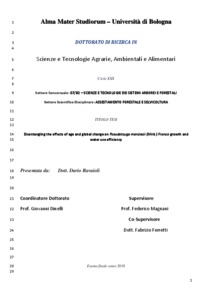Ravaioli, Dario
(2018)
Disentangling the effects of age and global change on Pseudotsuga menziesii (Mirb.) Franco growth and water use efficiency, [Dissertation thesis], Alma Mater Studiorum Università di Bologna.
Dottorato di ricerca in
Scienze e tecnologie agrarie, ambientali e alimentari, 30 Ciclo. DOI 10.6092/unibo/amsdottorato/8620.
Documenti full-text disponibili:
![[img]](http://amsdottorato.unibo.it/8620/1.hassmallThumbnailVersion/Ravaioli_dario_tesi.pdf)  Anteprima |
|
Documento PDF (English)
- Richiede un lettore di PDF come Xpdf o Adobe Acrobat Reader
Disponibile con Licenza: Salvo eventuali più ampie autorizzazioni dell'autore, la tesi può essere liberamente consultata e può essere effettuato il salvataggio e la stampa di una copia per fini strettamente personali di studio, di ricerca e di insegnamento, con espresso divieto di qualunque utilizzo direttamente o indirettamente commerciale. Ogni altro diritto sul materiale è riservato.
Download (4MB)
| Anteprima
|
Abstract
The recent alterations in forests growth could be the result of a combination of different climatic and non-climatic factors, as rising atmospheric [CO2], temperature fluctuations, atmospheric nitrogen deposition and drought stress. This study tests the potential effects of global change on trees, assessing the relative importance and functional relationships between environmental drivers and long-term growth trend, as well as physiological response. To investigate such effects, we applied Generalized additive models (GAMs) technique, decoupling the non-linear age related effect from co-occurring environmental effects on basal area increments (BAI) series and isotope proxies (δ13C and δ18O). Two Douglas fir (Pseudotsuga menziesii (Mirb.) Franco) chronosequence were considered; the first one, comprises four different age classes (age 65-, 80-, 95- and 120-) and is a even-aged stands plantation located in Italy, while the second one is an old-growth Californian stand, with three age classes (age 100, 200, 300). Results show a 22.9% decrease of the general BAI growth trend over last decades for the Italian Douglas-fir chronosequence, when the age-size non-linear effect was removed. A related trend in water use efficiency (iWUE=Amax/gs, the ratio between photosynthetic assimilation and stomatal conductance) was observed in the same period. Thus, through the application of the so called dual isotope approach, was possible to attribute to a reduction in Amax the cause of such a trend, probably driven by a reduction in N deposition. On other hand, BAI trend accounted for the Californian old-growth stand shows an increase of roughly the 60% since the 1960, which was found to be mostly determinate by a strong effect of atmospheric [CO2]. These founding highlight how this species has been affected by global change impact in both sits and provide important insights on its future behavior, potentially driving management choices.
Abstract
The recent alterations in forests growth could be the result of a combination of different climatic and non-climatic factors, as rising atmospheric [CO2], temperature fluctuations, atmospheric nitrogen deposition and drought stress. This study tests the potential effects of global change on trees, assessing the relative importance and functional relationships between environmental drivers and long-term growth trend, as well as physiological response. To investigate such effects, we applied Generalized additive models (GAMs) technique, decoupling the non-linear age related effect from co-occurring environmental effects on basal area increments (BAI) series and isotope proxies (δ13C and δ18O). Two Douglas fir (Pseudotsuga menziesii (Mirb.) Franco) chronosequence were considered; the first one, comprises four different age classes (age 65-, 80-, 95- and 120-) and is a even-aged stands plantation located in Italy, while the second one is an old-growth Californian stand, with three age classes (age 100, 200, 300). Results show a 22.9% decrease of the general BAI growth trend over last decades for the Italian Douglas-fir chronosequence, when the age-size non-linear effect was removed. A related trend in water use efficiency (iWUE=Amax/gs, the ratio between photosynthetic assimilation and stomatal conductance) was observed in the same period. Thus, through the application of the so called dual isotope approach, was possible to attribute to a reduction in Amax the cause of such a trend, probably driven by a reduction in N deposition. On other hand, BAI trend accounted for the Californian old-growth stand shows an increase of roughly the 60% since the 1960, which was found to be mostly determinate by a strong effect of atmospheric [CO2]. These founding highlight how this species has been affected by global change impact in both sits and provide important insights on its future behavior, potentially driving management choices.
Tipologia del documento
Tesi di dottorato
Autore
Ravaioli, Dario
Supervisore
Co-supervisore
Dottorato di ricerca
Ciclo
30
Coordinatore
Settore disciplinare
Settore concorsuale
Parole chiave
Pseudotsuga menziesii, BAI, iWUE, long-term trends, global change, GAMs, isotope dual approach.
URN:NBN
DOI
10.6092/unibo/amsdottorato/8620
Data di discussione
23 Aprile 2018
URI
Altri metadati
Tipologia del documento
Tesi di dottorato
Autore
Ravaioli, Dario
Supervisore
Co-supervisore
Dottorato di ricerca
Ciclo
30
Coordinatore
Settore disciplinare
Settore concorsuale
Parole chiave
Pseudotsuga menziesii, BAI, iWUE, long-term trends, global change, GAMs, isotope dual approach.
URN:NBN
DOI
10.6092/unibo/amsdottorato/8620
Data di discussione
23 Aprile 2018
URI
Statistica sui download
Gestione del documento:


 Login
Login
